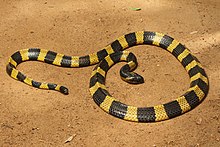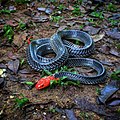Bungarus
| Bungarus | |
|---|---|

| |
Bungarus fasciatus (banded krait), the largest species of krait
| |
| Scientific classification | |
| Domain: | Eukaryota |
| Kingdom: | Animalia |
| Phylum: | Chordata |
| Class: | Reptilia |
| Order: | Squamata |
| Suborder: | Serpentes |
| Family: | Elapidae |
| Genus: | Bungarus Daudin, 1803 |
| Type species | |
Bungarus annularis
Daudin, 1803[1] | |
| Synonyms[1] | |
Bungarus (commonly known as kraits
Distribution
Kraits are found in
Description
Kraits usually range between 1.0 and 1.5 m (3 ft 3 in and 4 ft 11 in) in total length (including tail), although specimens as large as 2.0 m (6 ft 7 in) have been observed. The
. Kraits have pronounced dorsolateral flattening, which causes them to be triangular in cross section.Ecology
Kraits are
Venom
Bungarus contains some species that are among the most venomous land snakes in the world, to mice, based on their
These phases of envenomation may or may not be experienced in all parts of the body; they may or may not be experienced simultaneously. The severity of the bite itself and the actual dosage of venom delivered plays a role in the intensity of symptoms. As kraits are mainly nocturnal, encounters with humans are rare during the daytime. Bites mainly occur after sunset, and are often (initially) painless; thus, a bite may go unnoticed if the victim is sleeping or otherwise does not see or notice the krait, further prolonging envenomation damage within the body. Still—whenever possible—medical treatment should be sought posthaste, as a bite from a krait is considered potentially life-threatening. All venomous snake bites must be taken seriously as an immediate medical emergency.
Typically, victims will start to notice severe abdominal cramps accompanied by progressive muscular paralysis, and frequently starting with ptosis. As no local symptoms are usually seen, a patient should be carefully observed for tell-tale signs of paralysis (e.g. the onset of bilateral ptosis, diplopia, and dysphagia), and subsequently treated (as quickly as possible) with antivenom. Frequently, little or no pain occurs at the site of a krait bite, which can provide false reassurance to the victim. The major medical difficulty of envenomated patients is the lack of medical resources (especially intubation supplies and mechanical ventilators in rural hospitals) and potential for ineffectiveness by the antivenom.
Upon arriving at a healthcare facility, support must be provided until the venom has
Mortality rates caused by bites from the members of this genus vary by species; according to University of Adelaide Department of Toxicology, bites from the banded krait have a mortality rate of 1–10% in untreated humans,[9] while that of the common krait is 70–80%.[10] In common with those of all other venomous snakes, the death time and fatality rate resulting from bites of kraits depend on numerous factors, such as the venom yield and the health status of the victim.
Polyvalent elapid antivenom is effective in neutralizing of the venoms of B. candidus and B. flaviceps, and rather effective for B. fasciatus, and the monovalent B. fasciatus antivenom is also moderately effective.[11]
Species
| Image | Species | Authority | Subsp.* | Common name | Geographic range |
|---|---|---|---|---|---|

|
Bungarus andamanensis | Biswas & Sanyal, 1978 | 0 | South Andaman krait
|
India (Andaman Island) |

|
Bungarus bungaroides | ( Cantor , 1839)
|
0 | Northeastern hill krait
|
|

|
Bungarus caeruleus T
|
( Schneider , 1801)
|
0 | Common krait, Indian krait | Afghanistan, Pakistan, India (Bengal, Maharashtra, Karnataka), Sri Lanka, Bangladesh, Nepal |

|
Bungarus candidus | (Linnaeus, 1758) | 0 | Blue krait, Malayan krait | Cambodia, |

|
Bungarus ceylonicus | Günther, 1864 | 1 | Ceylon krait, Sri Lankan krait
|
Sri Lanka |

|
Bungarus fasciatus
|
(Schneider, 1801) | 0 | Banded krait | Bangladesh, Brunei, Myanmar, Cambodia, south China (incl. Hong Kong, Hainan), north-east India, Bhutan, Nepal, Indonesia (Sumatra, Java, Borneo), Laos, Macau; Malaysia (Malaya and East Malaysia), Singapore, Thailand and Vietnam. |

|
Bungarus flaviceps
|
(Reinhardt, 1843) | 1 | Red-headed krait | South Thailand, South Myanmar, Cambodia, Vietnam, Billiton, Borneo )
|

|
Bungarus lividus
|
Cantor, 1839 | 0 | Lesser black krait | India, Bangladesh, Nepal |

|
Bungarus magnimaculatus | Wall & Evans, 1901 | 0 | Burmese krait
|
Myanmar |
Bungarus multicinctus
|
Blyth, 1861 | 1 | Many-banded krait | Taiwan, south China (Hong Kong, Hainan), Myanmar, Laos, northern Vietnam, and Thailand | |

|
Bungarus niger
|
Wall, 1908 | 0 | Black krait, Greater black krait | India (Assam, Sikkim), Nepal, Bangladesh, Bhutan |
| Bungarus persicus | Abtin, Nilson, Mobaraki, Hosseini & Dehgannejhad, 2014 | 0 | Persian krait, Iranian krait | Iran | |

|
Bungarus sindanus | Boulenger, 1897 | 2 | Sind krait
|
Southeast Pakistan, India |
| Bungarus slowinskii[12] | Kuch, Kizirian, Q. Nguyen, Lawson, Donnelly & Mebs, 2005 | 0 | Red River krait
|
Northern Vietnam, Thailand, Laos, Cambodia. | |

|
Bungarus suzhenae | Chen, Shi, S. C., Vogel, Ding, & Shi, 2021 | 0 | Suzhen's krait
|
China (Yunnan), Myanmar (Kachin State) |

|
Bungarus walli | Wall, 1907 | 0 | Wall's krait | India (Uttar Pradesh), Nepal, Bangladesh |
*) Not including the
T) Type species
See also
References
- ^ a b "Bungarus". RepFocus - A Survey of the Reptiles of the World. Rune Midtgaard. Retrieved 21 July 2021.
- ^ "krait, n." Oxford English Dictionary Online. Oxford University Press (accessed June 30, 2014).
- ^ "krait". American Heritage Dictionary. Accessed June 30, 2014.
- ^ SurvivalIQ: Krait
- ^ Smith, Malcolm A. (1943). The Fauna of British India, Ceylon and Burma, Including the Whole of the Indo-Chinese Sub-region. Reptilia and Amphibia. Vol. III.—Serpentes. London: Secretary of State for India. (Taylor and Francis, printers). xii + 583 pp. (Bungarus, genus and species, pp. 407-418).
- ^ Richard Mastenbroek's Elapid Pages: Kraits (Bungarus ssp.)
- ^ "Living in Indonesia:Banded Krait". Archived from the original on 2006-05-08. Retrieved 2006-06-01.
- ISBN 81-901873-0-9.
- ^ "Bungarus fasciatus ". WCH Clinical Toxinology Resources.
- ^ "Bungarus caeruleus ". WCH Clinical Toxinology Resources. Archived from the original on 2016-10-16. Retrieved 2011-11-10.
- ^ Nget Hong Tan. "Antivenoms against Malaysian poisonous snakes". University of Malaya. Archived from the original on 2009-02-28. Retrieved 2009-09-23.
- ^ Kuch, Ulrich; Kizirian, David; Nguyen, Quang Truong; Lawson, Robin; Donnelly, Maureen A.; Mebs, Dietrich (2005). "A new species of krait (Squamata: Elapidae) from the Red River System of Northern Vietnam". Copeia 2005 (4): 818-833. (Bungarus slowinskii, new species).
Further reading
- Boulenger GA (1896). Catalogue of the Snakes in the British Museum (Natural History). Volume III., Containing the Colubridæ (Opisthoglyphæ and Proteroglyphæ) ... London: Trustees of the British Museum (Natural History). (Taylor and Francis, printers). xiv + 727 pp. + Plates I-XXV. (Genus Bungarus, pp. 365-366, Figure 26, three views of skull).
- Daudin FM (1803). Histoire Naturelle, Génerale et Particulière des Reptiles; Ouvrage faisant suite aux Œuvres de Leclerc de Buffon, et partie de Cours complete d'Histoire naturelle rédigé par C.S. Sonnini, membre de plusieurs Sociétés savantes. Tome cinquième [Volume 5]. Paris: F. Dufart. 365 pp. (Bungarus, new genus, p. 263). (in French).
External links
- Genus Bungarus at The Reptile Database
- "Bungarus". Integrated Taxonomic Information System. Retrieved 6 May 2006.
- Detailed account of Joe Slowinski's death via krait bite Archived 2020-05-27 at the Wayback Machine
